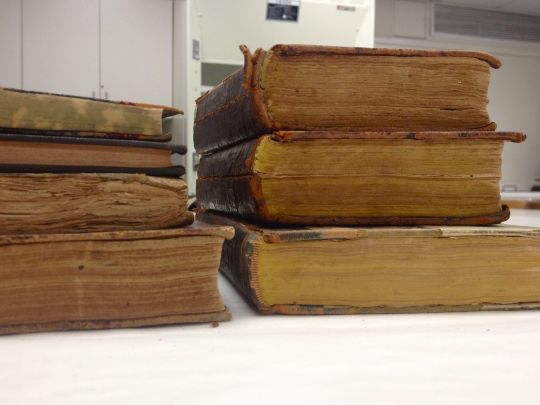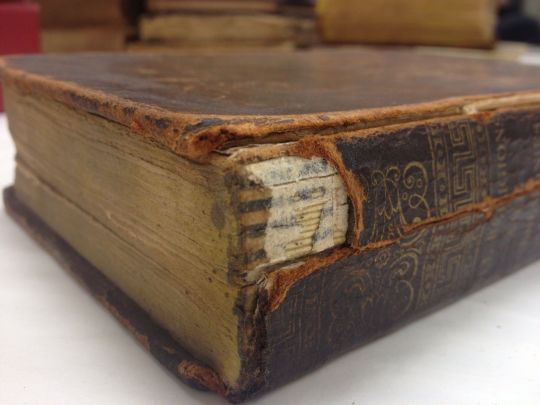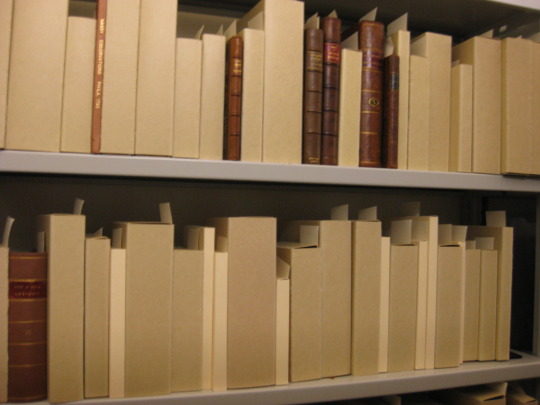
Bagged Sobel Collection books in the
American Jewish Historical Society stacks. The Sobel collection of
early American Jewish printing was donated by the late Morris Sobel, former
president of the American Jewish Historical Society, and his wife, Eleanor.
Here in the Werner
J. and Gisella Levi Cahnman Conservation Laboratory we aim to prolong the life
of the Center’s extensive paper-based collections. Flattening, cleaning and
mending documents in need of attention are routine procedures for us. Careful examination
of objects leads to an appropriate course of action. However, sometimes we find
that there is not an obvious solution to every problem. Lately, we have faced red rot, a challenging, but common issue
that affects leather-bound books in many libraries.
The American
Jewish Historical Society’s Sobel Collection is now receiving attention
for red rot – the leather bindings have become brittle and are crumbling away
as red powder. As a new intern in the summer of 2014, it was my job to determine
why this collection was previously housed in plastic bags. I quickly discovered
that red rot was the primary reason for bagging. The books surveyed were
treated for structural and mold damage. For red rot, we aimed simply to prevent
further loss.

American Jewish Historical Society’s
Sobel
collection books in the lab immediately after un-bagging. Red rot afflicts the
edges of the top two books of the right stack. The leather has become so
brittle as to have completely split down the spines. Photo credit: Shannon
Mulshine.
The
mechanisms behind red rot are not fully understood, but typically affect 19th
and early 20th century vegetable-tanned leather. Leather
manufacturing chemicals and rampant pollution following the onset of the
Industrial Revolution together spelled trouble for leathers of this period (Falls
and Simonds, 2014). The Sobel Collection books were bound, or rebound, in the 19th
c. and 20th c. The leather is
therefore vulnerable to such damage.

Minor
red rot along the edges, shoulder, and spine of a book in theAmerican Jewish Historical Society’s
Sobel Collection.
Photo credit: Shannon Mulshine.
Red powder
from these books breaks away during handling and soils all that it touches. The
leather is brittle, which causes cracks and losses, as seen in the photographs
above. The bagging of the Sobel Collection by a previous caretaker, served as a
cost-effective solution to a messy problem. The bags kept loose pieces together
to avoid loss of important information and prevented powder from soiling
shelves and neighboring books.

American Jewish Historical Society’s
Sobel collection books removed from the plastic
bags in which they were previously stored, now in custom-fit book wrappers.
Photo credit: Shannon Mulshine.
The Sobel
Collection survey is being re-initiated by a new intern, Christina, who will continue
to replace the bags with book wrappers. Because the quality of the plastic bags
is unknown, this will prevent potential harm to the books related to plastic deterioration.
Book wrappers are made with acid-free, lignin-free board and better support the
structurally unstable books, while still containing loose debris and red powder
and acting as a buffer against pollutants and changes in the environment.
Red rot
cannot be reversed. Like our book wrappers, most treatments aim simply to prevent
further loss of leather powder and seal against pollutant penetration. Consolidation, for example, involves impregnating
leather with an adhesive. We are excited to hear about new, innovative
treatments, such as one recently developed by The Leather Conservation Centre,
Northampton (Fletcher et al., 2012), and hope that they will one day enter the
conservator’s toolbox of options for dealing with red rot on leather bindings.

Poetry excerpts found between
the leaves of an American Jewish Historical Society’s Sobel Collection book of
religious instruction. Photo credit: Shannon Mulshine.
As my
two-year tenure as an intern comes to an end, I reflect affectionately on my
first survey and rehousing project. Exposure to historical materials and their condition
issues lays the foundations of successful examination and connoisseurship, critical
to the conservation profession. The
American Jewish Historical Society
Sobel Collection books are stabilized
in their new housing and may continue to benefit one day if a better solution
arises. Our intervention assumes its place as just one of many human efforts –
including the binding and bagging of the books – to best serve our material
culture.
Written by
Shannon Mulshine, Graduate Conservation Intern at The Center for Jewish
History, and Andrew W. Mellon Fellow in Library & Archive Conservation
specializing in paper conservation at The Conservation Center of the Institute
of Fine Arts, NYU
Citations:
Falls, Eva and Lucas Simonds. “Red Rot”. AIC Wiki. American Institute for Conservation of Historic and
Artistic Works, 20 August 2014. Web. 5 August 2016. <http://www.conservation-wiki.com/wiki/Red_rot>
* Fletcher, Yvette et al. “Investigation of
Acid-Deterioration in Leather Leading towards Finding a Suitable
Product for Treatment.” Leather & Related Materials Working Group
Newsletter. International Council of Museums – Committee for Conservation,
12 January 2012.
* Can be found at:”New Treatment
for Red Rot”. jeff peachey. Blog. Jeff Peachey, 31 January 2012. Web. 5
August 2016. <https://jeffpeachey.com/tag/leather-conservation-centre/>

